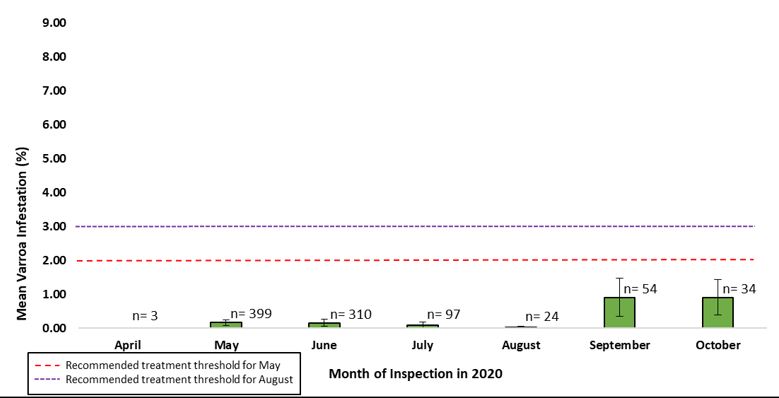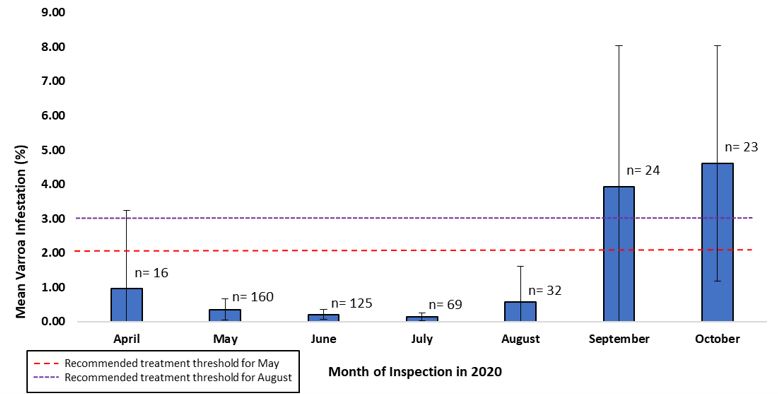2020 Provincial Apiarist report
2020 Season highlights
The Ministry of Agriculture, Food and Rural Affairs’ (OMAFRA) Apiary Program conducted regular and targeted inspections.
Approximately 39,231 honey bee colonies were shipped outside of Ontario for the pollination of blueberry and cranberry crops in eastern Canada.
Ontario beekeepers reported an overall overwinter honey bee mortality of 19% for the winter of 2019–2020. This was lower than the overwinter mortality reported in the previous year (23%).
Notable statistics about the 2020 Ontario beekeeping industry include:
- number of registered beekeepers: 2,856
- number of registered colonies: 101,989
- average honey yield/colony: 38 kg (84 lb) per colony
- total estimated honey crop: 3.9 million kg (8.5 million lb)
- overwinter honey bee losses reported by commercial beekeepers: 19%
Pest and disease levels
During the 2020 beekeeping season, OMAFRA inspected a total of 574 bee yards. The presence of common apiary pests and diseases was assessed by ministry apiary inspectors through the brood nest inspection of 5,410 colonies. Inspectors checked for varroa mites in 1,370 of the colonies receiving brood nest inspections and checked for small hive beetle in an additional 9,926 colonies through top bar inspections. The prevalence of the following diseases among inspected colonies were:
- American foulbrood: 0.09%
- European foulbrood: 0.43%
- sacbrood virus: 0.28%
The data represents the colonies inspected in 2020 and is not necessarily reflective of the beekeeping industry across the province.
American foulbrood (Paenibacillus larvae)
American foulbrood (AFB), a bacterial disease of honey bees, was detected in 5 honey bee colonies or 0.09% of the colonies inspected in Ontario. The 2020 data represents a decrease in AFB from 2019 when AFB was observed in 0.82% of colonies.
Sample analysis continues to confirm that the strains of AFB circulating in Ontario remain susceptible to oxytetracycline. This is good news since antibiotic resistant strains of AFB have been detected in other jurisdictions across Canada. Antibiotics are not a cure for AFB, rather they are to be used prudently as a management option to reduce the chances of clinical (observable) AFB infection becoming established in a colony. When a colony has clinical AFB, antibiotics are not effective, and all infected colonies must be destroyed.
AFB remains a very serious disease of honey bees with the potential to cause economic loss within a beekeeping operation and at a population level. Beekeepers who observe symptoms of AFB should contact their local Apiary Inspector immediately.
Small hive beetle (Aethina tumida)
Small hive beetle (SHB) is an insect pest of honey bees. A total of 38 apiaries, both commercial (operating 50 or more colonies) and small-scale (operating 49 or fewer colonies), tested positive for SHB in Ontario. This represents an increase in new detections in 2020 when compared to 2019 (n=26). Positive findings of SHB may be overrepresented in inspection results due to the high rate of inspection of colonies in the Niagara region to allow for the movement of colonies for out of province pollination. Colonies in this region make up a large proportion of apiary inspections.
SHB is capable of damaging colonies when conditions are ideal and when colonies are not managed properly. However, there have been very few reports of SHB creating damage under Ontario conditions. The presence of larvae, which is the main cause of SHB damage to colonies, is documented during apiary inspections. Although SHB larvae has been found in honey bee colonies in Ontario, they are typically at low, non-damaging levels of infestation. Any potential impact from SHB will depend on the beekeeper’s management practices and specific environmental conditions that may allow beetle larvae to increase. To date, the impact of this pest in Ontario has been limited.
The ministry has an online map showing the number of SHB-positive bee yards confirmed in each township. This map not only provides current data to other jurisdictions that import Ontario honey bees, but also informs beekeepers about where SHB has been detected in Ontario, which helps them to manage the risk to their beekeeping activities.
Varroa mites (Varroa destructor)
The presence of varroa mites, which are parasitic mites of honey bees, is widespread in North America and they are found in apiaries across the province. This pest has been identified as the main culprit for the death and reduced populations of overwintered honey bee colonies in Ontario. Monitoring varroa mite infestation throughout the season continues to be essential for beekeepers to confirm the degree of infestation at key times in the season, to determine if and when treatments are needed to reduce varroa levels, what type of treatment may be required, and to determine if mite control methods were successful.
Ministry apiary inspectors sampling for varroa mites, a common and very serious pest of honey bees, during regular apiary inspections typically documented low levels of infestation early in the beekeeping season for both commercial and small-scale beekeepers and extending into summer for many commercial beekeepers. Across the province, 1,370 (921 commercial, 449 small-scale) colonies were inspected for varroa mites using a standard alcohol wash (a sample of approximately 300 bees collected from the brood nest, washed in alcohol and the varroa mites filtered and quantified).
As varroa mites are widely distributed across the province, the prevalence of these mites is not as informative as the degree of infestation. Guzman et al. (2010) established treatment thresholds for varroa mite infestations. Colonies should be treated for varroa mites in:
- May if the infestation is greater than 2%
- August if the infestation is greater than 3%


Among commercial operations, the mean varroa mite infestation remained below treatment thresholds and ranged from a low of 0.00% in April to a high of 0.90% in September and October (Figure 1). The degree of varroa mite infestation among small-scale operations was much higher in comparison to commercial beekeepers and ranged from a low of 0.14% in July to a high of 4.61% in October (Figure 2).
The low degree of infestation among commercial honey bee operations may confirm the success that some beekeepers have had with the management of varroa mites. Some commercial operations, however, anecdotally reported high varroa mite infestations in late fall. While most of the colonies sampled (represented by mean) during inspection for varroa mites were below the treatment threshold in fall (3 varroa mites per 100 bees), there were colonies that were above the threshold. This demonstrates that some colonies were likely going into the winter with damaging levels of varroa mite infestation.
Consistent with previous years, commercial beekeepers demonstrate a lower degree of infestation compared to small-scale beekeepers and this likely confirms the success this group of beekeepers is having with the management of varroa mites. However, fewer colonies operated by both commercial and small-scale beekeepers were inspected in the fall and small sample sizes may have contributed to the observed increase in mean varroa mite infestation for small-scale operations in September and October.
This report highlights the importance of late season monitoring for varroa mites, both in September and in October, after varroa mite treatment has been applied, to ensure that the treatment was effective at lowering the level of infestation.
Treatments for varroa mites
Treatments for varroa mites and any other pest or disease must be legally registered in Canada for use, including the product, the active ingredients and the application method(s). For effective treatment of varroa mites and to reduce the development of resistant populations, beekeepers must follow label directions when using control products. For example, if the label says to use 1 strip of an acaricide per 5 frames of bees, then a double brood chamber needs 4 strips. The Treatment options for honey bee pests and diseases in Ontario lists the only methods that should be used.
Honey production
Honey survey questionnaires were mailed to registered Ontario commercial beekeepers to estimate the average honey production in the province. Responses were received from 26% of commercial beekeepers, representing approximately 13,200 colonies across the province.
Based on the responses, the estimated average honey production in Ontario was 37.9 kg (83.6 lb) per colony. This is a slight decrease in honey production from 2019 (39.8 kg or 87.7 lb per colony).
Pollination services
There is a demand for Ontario honey bee colonies for pollination services for berry crops in eastern Canada (Quebec, New Brunswick, Nova Scotia and Prince Edward Island). Approximately 39,231 honey bee colonies were moved from Ontario to eastern Canada in 2020 for the purpose of pollination. This number is up from the 30,706 honey bee colonies that left the province in 2019 for pollination services. This increase in colony numbers reflects the increase demand in pollination requirements for the blueberry sector in eastern Canada as well as the increase in available colonies managed by Ontario beekeepers.
As is now set practice, Ontario and the eastern Canadian provinces worked collaboratively to define pre-transportation inspection requirements before colonies were shipped across provincial borders. The spread of small hive beetle from regions in Ontario to eastern Canada remained a concern for inspection requirements in 2020.
Honey bee mortality
Overwinter honey bee mortality
During the spring of 2020, a survey was used to estimate overwinter honey bee colony losses. The survey was distributed to 119 registered commercial beekeepers. Responses were received from 50% of the beekeepers surveyed representing 40,562 colonies across the province. Based on the results of the survey, commercial beekeepers reported an approximate 19% overall honey bee colony loss during the 2019–2020 winter. This was a decrease from the 23% winter loss reported in the previous year (2018–2019). In Canada, 15% is considered the maximum acceptable winter loss. Small-scale beekeepers reported a higher winter loss (30%) then that of the commercial sector. See the full report on 2020 overwinter losses.
In-season honey bee mortality
A honey bee incident is defined as atypical effects characterized by bee mortality, or sub-lethal effects observed in a honey bee colony and suspected by a beekeeper to be related to pesticide exposure. OMAFRA’s Agriculture Information Contact Centre receives reports of honey bee incidents in Ontario. These are shared with the Ministry of the Environment, Conservation and Parks (MECP) and Health Canada’s (HC) Pesticide Management Regulatory Agency (PMRA).
Upon review of the information provided for a reported incident, an inspection may be conducted of the reported yard(s) by either OMAFRA (for a honey bee health issue) or by MECP or HC (for a pesticide related issue). In 2020, OMAFRA received 14 in-season honey bee mortality incident reports.